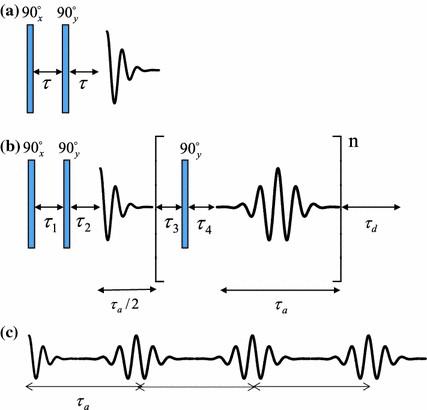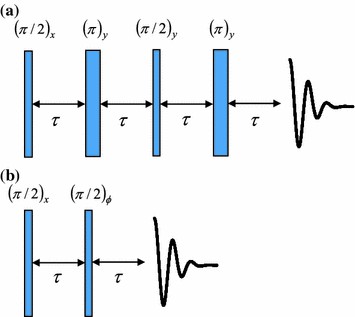Functional Materials Analysis
The function of solid materials is significantly influenced by the structure and dynamics of local spaces formed by molecules and ions in the solid material. Therefore, to develop innovative functional solid materials, material design based on detailed local structural and dynamic analysis is becoming increasingly important. Solid-state nuclear magnetic resonance spectroscopy is a very powerful tool for studying molecular dynamics and local structures in solid materials. Linear analysis of 2H NMR spectra using spectral simulation is an effective method for studying molecular motion in solid materials.
As an expert in the field of nuclear magnetic resonance, Creative Biostructure can analyze the molecular motion related to the functions of solid materials for customers through 2H NMR spectroscopy.
Our Principles
 Figure 1. Pulse sequences for the 2H NMR broad line spectrum and the QCPMG spectrum. a. Quadrupolar echo sequence, b. QCPMG sequence, c. NMR signal obtained by the QCPMG sequence. (Mizuno, 2017)
Figure 1. Pulse sequences for the 2H NMR broad line spectrum and the QCPMG spectrum. a. Quadrupolar echo sequence, b. QCPMG sequence, c. NMR signal obtained by the QCPMG sequence. (Mizuno, 2017)
The analysis can be performed using a 2H NMR spectral simulation method. Wide line spectroscopy and QCPMG spectroscopy can be used to study the modes and rates of molecular motion over a wide dynamic range. Combining 2H NMR wide line spectroscopy with QCPMG spectroscopy is very effective for analyzing dynamic heterogeneity, which is closely related to the function of polymers. Simulating 2H NMR spectroscopy, including quadrupole interactions and paramagnetic effects, is essential for analyzing molecular motion in paramagnetic materials.
Our Service Content and Methods
 Figure 2. Pulse sequences of a 2H NMR broad line spectrum for paramagnetic materials. a. Shift-compensated quadrupolar echo sequence, b. exorcycled quadrupolar echo sequence. (Mizuno, 2017)
Figure 2. Pulse sequences of a 2H NMR broad line spectrum for paramagnetic materials. a. Shift-compensated quadrupolar echo sequence, b. exorcycled quadrupolar echo sequence. (Mizuno, 2017)
The alignment of the 2H NMR spectrum is dominated by quadrupole interactions and is very sensitive to molecular motion.
| Object | Methods |
|---|---|
| Obtaining molecular motion patterns and rates in the dynamic range of 104 – 107 Hz. | Linear analysis of 2H NMR broad spectral lines of powder samples using spectral simulation. |
| Modes and rates of molecular motion at 103 and 108 Hz scales. | It can be analyzed by the lineshape and linewidth of the 2H NMR quadrupole Carr Purcell Meiboom Gill (QCPMG) spectrum. |
| Analysis of molecular motion in paramagnetic materials. | By simulating the 2H NMR spectrum, including the paramagnetic effect. |
MOF/PCP Analysis
Metal-organic frameworks (MOFs) or porous coordination polymers (PCPs) can be used to manufacture adjustable pore sizes and topologies, resulting in versatile architectures and applications, and have been actively studied, separated, catalyzed, and chemically sensed due to their applications in gas storage.
We can analyze the dynamics of nanospace in MOF (PCP) through solid-state 2H NMR spectroscopy, such as
- Adsorption molecular analysis.
- Rotation of bridge ligands.
- Analyzing the rotational motion of ligands before and after adsorption.
- Temperature-dependent changes before and after adsorption.
Analysis of Solid Proton Conducting Materials
In polymer materials, dynamic heterogeneity is closely related to these physical properties. To study the flexible and rigid regions in composite materials, it is very effective to use a combination of 2H NMR wide line spectroscopy and QCPMG spectroscopy. The aspects we can analyze include:
- The isotropic rotational rate of molecules.
- Analyzing the proportions of molecular quasi-isotropic rotation, rotational vibration, and isotropic rotation.
Spin Cross Material Analysis
- Measurement of 2H NMR spectra in paramagnetic high spin (HS) and antimagnetic low spin (LS) states.
- The free rotation and rotation inhibition in the LS state were evaluated from the 2H NMR spectrum at HS and state.
Creative Biostructure is committed to providing high-quality NMR analysis services to advance the life sciences fields. If you have any questions or needs, please contact us and our customer service staff will help you the first time.
Ordering Process
Reference
- Mizuno M. Solid-state 2H NMR studies of molecular motion in functional materials. Experimental Approaches of NMR Spectroscopy: Methodology and Application to Life Science and Materials Science. 2018: 341-364.

